Oh sleep! it is a gentle thing,
Beloved from pole to pole!
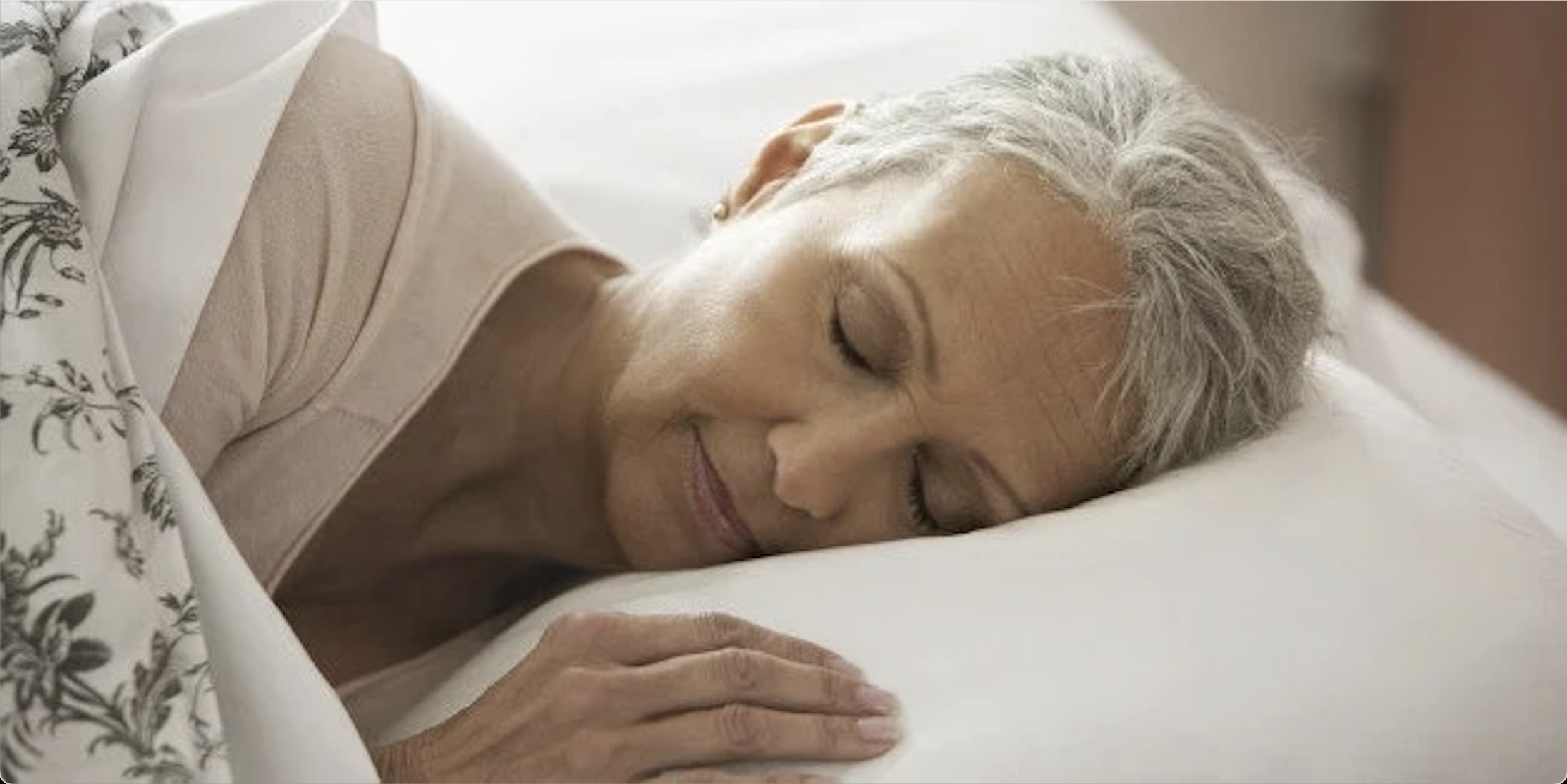 The Rime of the Ancient Mariner (text of 1834)
By Samuel Taylor Coleridge
https://www.poetryfoundation.org/poems/43997/the-rime-of-the-ancient-mariner-text-of-1834
PART V
Oh sleep! it is a gentle thing,
Beloved from pole to pole!
To Mary Queen the praise be given!
She sent the gentle sleep from Heaven,
That slid into my soul.
The silly buckets on the deck,
That had so long remained,
I dreamt that they were filled with dew;
And when I awoke, it rained.
The Rime of the Ancient Mariner (text of 1834)
By Samuel Taylor Coleridge
https://www.poetryfoundation.org/poems/43997/the-rime-of-the-ancient-mariner-text-of-1834
PART V
Oh sleep! it is a gentle thing,
Beloved from pole to pole!
To Mary Queen the praise be given!
She sent the gentle sleep from Heaven,
That slid into my soul.
The silly buckets on the deck,
That had so long remained,
I dreamt that they were filled with dew;
And when I awoke, it rained.
OUTLINE
Why Sleep is Necessary
Monitoring Sleep
Problems Sleeping
Possible Sleep Problem Solutions
Insomnia (inability to sleep)
Sleep Apnea (stopped breathing)
Restless legs syndrome (RLS)
Why Sleep is Necessary
NIH: What Makes You Sleep?
https://www.nhlbi.nih.gov/health/sleep-deprivation/body-clock
NIH: Why Is Sleep Important?
https://www.nhlbi.nih.gov/health/sleep/why-sleep-important
https://www.nhlbi.nih.gov/resources?f%5B0%5D=language%3AEnglish
Sleep Foundation: Why Do We Need Sleep?
https://www.sleepfoundation.org/how-sleep-works/why-do-we-need-sleep
How Does Sleep Work?
https://www.youtube.com/watch?v=0LNdsTrQJCs (2+ min)
What Happens When We Sleep?
https://www.youtube.com/watch?v=eTgNgGO_bLs (2+ min)
Sleep is an essential function that allows your body and
mind to recharge, leaving you refreshed and alert when you
wake up. Healthy sleep also helps the body remain healthy
and stave off diseases. Without enough sleep, the brain
cannot function properly. This can impair your abilities to
concentrate, think clearly, and process memories.
Most adults require between seven and nine hours of nightly
sleep. Children and teenagers need substantially more sleep,
particularly if they are younger than five years of age.
Work schedules, day-to-day stressors, a disruptive bedroom
environment, and medical conditions can all prevent us from
receiving enough sleep. A healthy diet and positive
lifestyle habits can help ensure an adequate amount of sleep
each night.
How Your Brain’s Nightly Cleanse Keeps It Healthy
https://www.scientificamerican.com/article/how-sleep-cleans-the-brain-and-keeps-you-healthy/
During sleep, the brain’s glymphatic system, a network of
perivascular spaces, facilitates the removal of waste
products, including amyloid beta and tau proteins, which are
linked to Alzheimer’s disease. This process, which is most
active during deep sleep, is driven by the brain’s electrical
activity, particularly slow-wave sleep. Studies in both mice
and humans have shown that sleep enhances waste clearance,
suggesting a potential role for sleep in preventing
neurodegenerative diseases.
Humans Used to Sleep Twice Every Night. Here's Why It Vanished.
https://www.sciencealert.com/humans-used-to-sleep-twice-every-night-heres-why-it-vanished
Summary
For most of human history, people slept in two shifts, called
“first sleep” and “second sleep,” separated by a period of
wakefulness. This practice changed over the past two centuries due
to societal changes like artificial lighting and the Industrial
Revolution, which encouraged a single block of rest. Understanding
how our minds perceive time, especially in low light, can help
alleviate insomnia and promote better sleep.
Monitoring Sleep
Mayo Clinic: Sleep-tracking devices: Dos and don'ts
https://newsnetwork.mayoclinic.org/discussion/mayo-clinic-q-and-a-monitoring-sleep-with-fitness-trackers/
Sleep trackers may help improve your sleep, but don't jump
to conclusions based on your data. Get the facts from a Mayo
Clinic wellness specialist.
Adults need seven to nine hours of sleep a night, yet many
people don't get enough. A cascade of sleep-tracking devices
has recently hit the market. But can you trust the data? And
do they help improve your sleep? Mayo Clinic Healthy Living
Program wellness exercise specialist Thomas M. Rieck weighs
in on the do's and don'ts of sleep trackers.
Track your sleep on Apple Watch and use Sleep on iPhone
https://support.apple.com/en-us/HT211685
Track your sleep with Apple Watch
https://support.apple.com/guide/watch/track-your-sleep-apd830528336/watchos
The Apple Watch uses motion sensors and its accelerometer to
monitor your rest, and while that may seem insanely retro,
it works. We're continually comparing and testing the best
sleep trackers, and the Apple Watch is up there with the
most accurate devices in terms of tracking sleep duration.
We've used it extensively, and crucially, it does get that
sleep duration figure right. Many smartwatches will offer a
sleep duration that's eerily close to your time in bed,
while the Apple Watch is sensitive enough to discount
wake-ups and disturbances to give you an accurate sleep
duration figure.
Its figures are in the same ballpark as Fitbit and Whoop -
two of the leading sleep trackers from our testing - and
accuracy is one of the Apple Watch's strengths in this
regard.
The Apple Watch also uses the heart rate sensor to track
blood oxygen and heart rate, this isn't factored into the
assessment of your sleep - but you can check stats like
blood oxygen saturation and heart rate during sleep in the
Apple Health app, and keep an eye for any worrying trends.
Again, the likes of Fitbit, Withings, and Whoop make this a
core part of the sleep-tracking experience. Apple, on the
other hand, keeps things focused on duration and
consistency.
Some Sleep Data
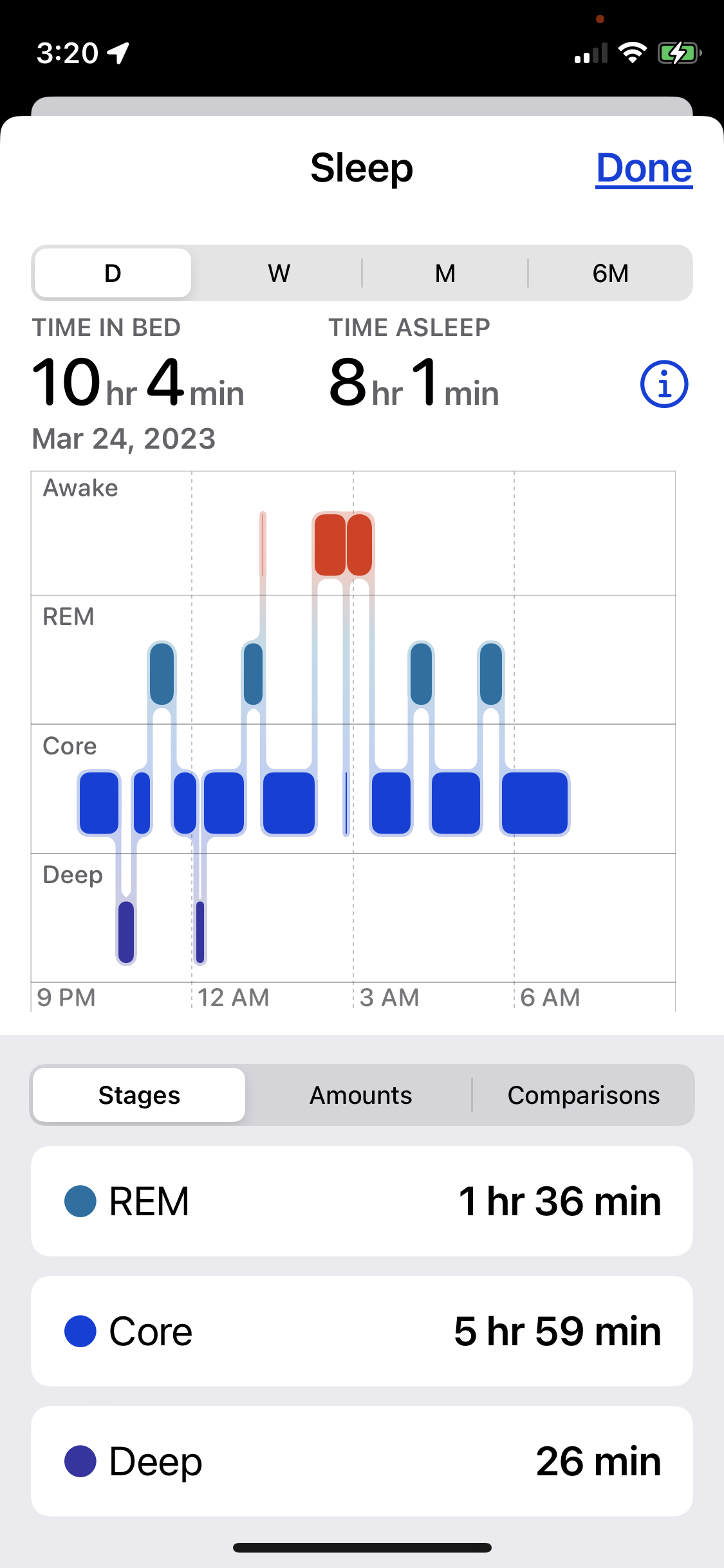
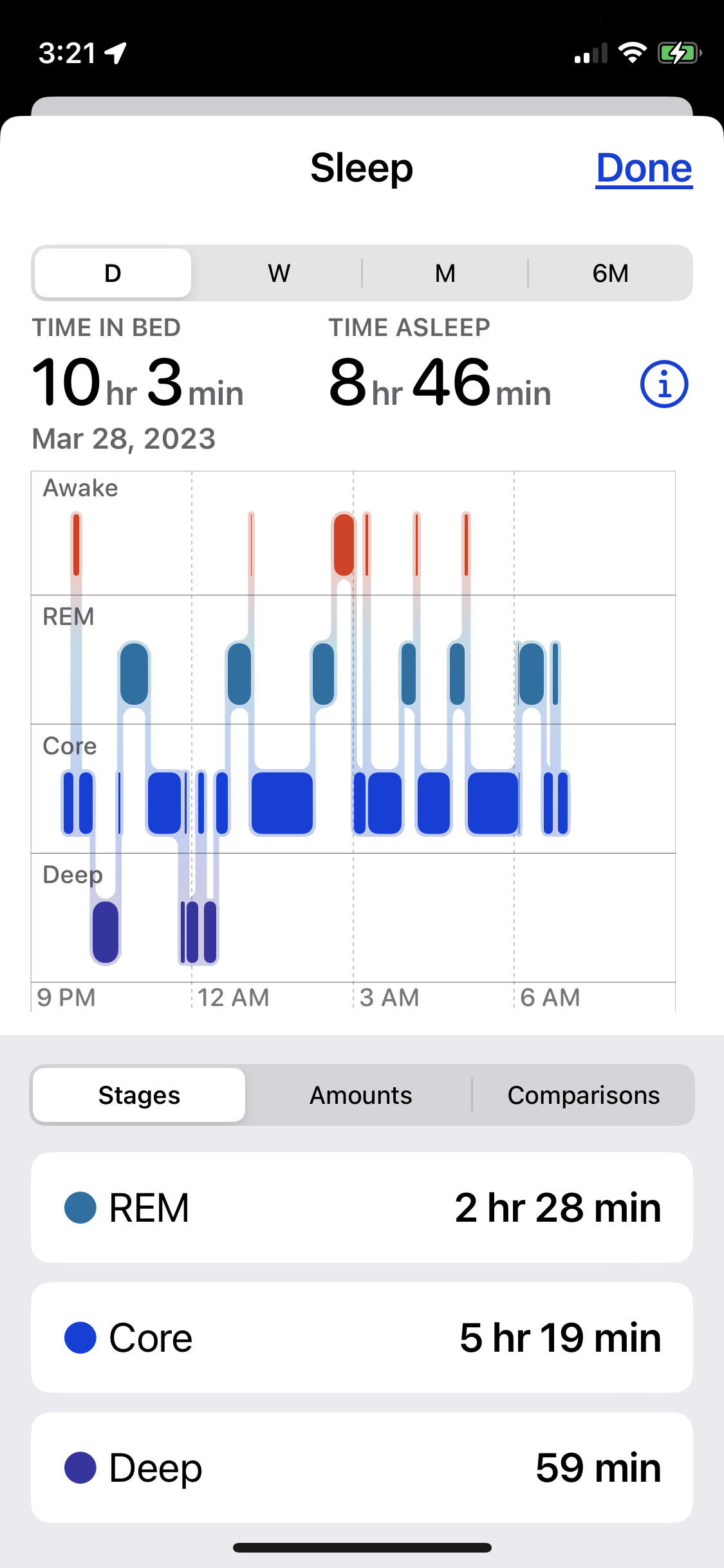
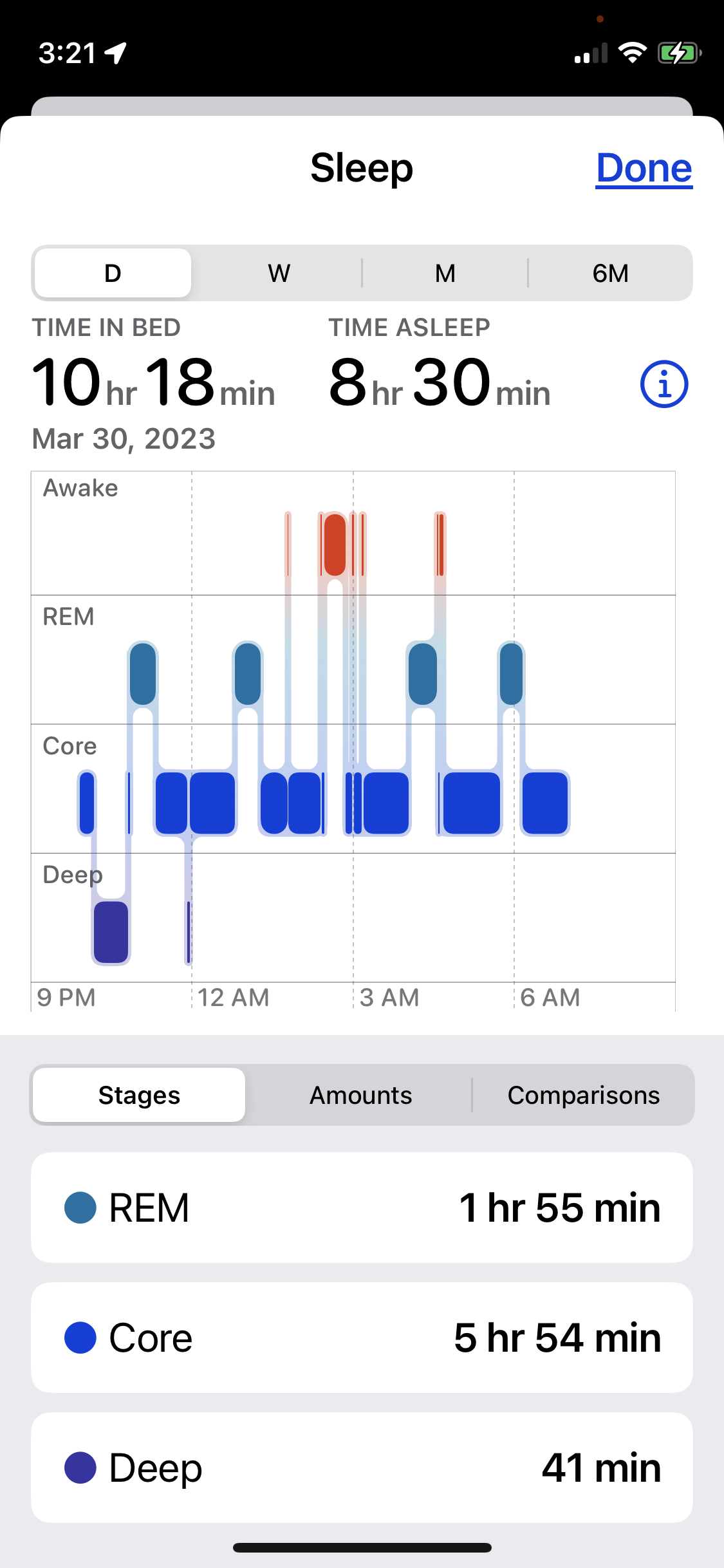 Understanding Sleep Stages
While you're sleeping, your body goes in and out of
different stages of sleep. In general, a sleep stage is
determined by the types of brain waves you produce. Most
people will cycle through the different stages several times
during a sleep session. While scientists and doctors can
recognize which stage you're in, they're still working to
fully understand the impact each stage has on the body.
Awake
You may find yourself awake during parts of a sleep session.
It's normal for people to wake up on occasion. It's possible
that you will fall right back to sleep and not remember
waking up during the night.
REM Sleep (N4)
This stage of sleep may play a role in learning and memory.
During this stage, your muscles are the most relaxed and
your eyes move rapidly from side to side. This is also when
most of your dreams occur.
Core Sleep (N1,N2)
Sometimes referred to as light sleep, this stage is
considered just as important as the others. This stage often
represents most of your time asleep each night. Brain waves
that may be important for cognition occur during this stage.
Deep Sleep (N3)
Also known as slow wave sleep because of the brain wave
patterns, this is the stage where body tissues are repaired
and essential hormones are released. This stage typically
happens in longer periods during the first half of your
sleep session. During deep sleep, the body is so relaxed
that it can be more difficult to wake up from this stage
than others.
Understanding Your Sleep Stages
There are many misconceptions around sleep stages and the
quality of sleep. While some may need more deep sleep,
others may not. Scientists and doctors are continuing to
explore the purpose of the different stages and the impact
they have on the body. By tracking your sleep stages and
paying attention to how you feel each morning, you may gain
insight into your own sleep.
Understanding Sleep Stages
While you're sleeping, your body goes in and out of
different stages of sleep. In general, a sleep stage is
determined by the types of brain waves you produce. Most
people will cycle through the different stages several times
during a sleep session. While scientists and doctors can
recognize which stage you're in, they're still working to
fully understand the impact each stage has on the body.
Awake
You may find yourself awake during parts of a sleep session.
It's normal for people to wake up on occasion. It's possible
that you will fall right back to sleep and not remember
waking up during the night.
REM Sleep (N4)
This stage of sleep may play a role in learning and memory.
During this stage, your muscles are the most relaxed and
your eyes move rapidly from side to side. This is also when
most of your dreams occur.
Core Sleep (N1,N2)
Sometimes referred to as light sleep, this stage is
considered just as important as the others. This stage often
represents most of your time asleep each night. Brain waves
that may be important for cognition occur during this stage.
Deep Sleep (N3)
Also known as slow wave sleep because of the brain wave
patterns, this is the stage where body tissues are repaired
and essential hormones are released. This stage typically
happens in longer periods during the first half of your
sleep session. During deep sleep, the body is so relaxed
that it can be more difficult to wake up from this stage
than others.
Understanding Your Sleep Stages
There are many misconceptions around sleep stages and the
quality of sleep. While some may need more deep sleep,
others may not. Scientists and doctors are continuing to
explore the purpose of the different stages and the impact
they have on the body. By tracking your sleep stages and
paying attention to how you feel each morning, you may gain
insight into your own sleep.
Problems Sleeping
NYT: Why Do I Feel More Anxious at Night?
https://www.nytimes.com/2023/03/23/well/mind/anxiety-night-sleep.html
1. Establish a caffeine cut-off
2. Put your worries onto paper
3. Give yourself something to look forward to
Incorporating a few of these suggestions might help quiet
your bedtime thoughts, experts explained, but if you're
consistently waking up tired, ask your doctor to refer you
to a sleep medicine specialist who can help you explore
potential causes. And, if your sleeplessness is stressing
you out, Dr. Pelayo had some words of comfort: "I want
people to know that they don't have to feel this way," he
said. "I tell my patients all the time, 'If you've ever
slept well, you can sleep well again.'"
CDC: Key Sleep Disorders
https://www.cdc.gov/sleep/about_sleep/key_disorders.html
Insomnia
Insomnia is characterized by an inability to initiate or
maintain sleep. It may also take the form of early morning
awakening in which the individual awakens several hours
early and is unable to resume sleeping. Difficulty
initiating or maintaining sleep may often manifest itself as
excessive daytime sleepiness, which characteristically
results in functional impairment throughout the day.
Before arriving at a diagnosis of primary insomnia, the
healthcare provider will rule out other potential causes,
such as other sleep disorders, side effects of medications,
substance abuse, depression, or other previously undetected
illness. Chronic psychophysiological insomnia (or "learned"
or "conditioned" insomnia) may result from a stressor
combined with fear of being unable to sleep. Individuals
with this condition may sleep better when not in their own
beds. Health care providers may treat chronic insomnia with
a combination of use of sedative-hypnotic or sedating
antidepressant medications, along with behavioral techniques
to promote regular sleep.
Narcolepsy
Excessive daytime sleepiness (including episodes of
irresistible sleepiness) combined with sudden muscle
weakness are the hallmark signs of narcolepsy. The sudden
muscle weakness seen in narcolepsy may be elicited by strong
emotion or surprise. Episodes of narcolepsy have been
described as "sleep attacks" and may occur in unusual
circumstances, such as walking and other forms of physical
activity. The healthcare provider may treat narcolepsy with
stimulant medications combined with behavioral
interventions, such as regularly scheduled naps, to minimize
the potential disruptiveness of narcolepsy on the
individual's life.
Restless Legs Syndrome (RLS)
RLS is characterized by an unpleasant "creeping" sensation,
often feeling like it is originating in the lower legs, but
often associated with aches and pains throughout the legs.
This often causes difficulty initiating sleep and is
relieved by movement of the leg, such as walking or kicking.
Abnormalities in the neurotransmitter dopamine have often
been associated with RLS. Healthcare providers often combine
a medication to help correct the underlying dopamine
abnormality along with a medicine to promote sleep
continuity in the treatment of RLS.
Sleep Apnea
Snoring may be more than just an annoying habit - it may be
a sign of sleep apnea. Persons with sleep apnea
characteristically make periodic gasping or "snorting"
noises, during which their sleep is momentarily interrupted.
Those with sleep apnea may also experience excessive daytime
sleepiness, as their sleep is commonly interrupted and may
not feel restorative.
Treatment of sleep apnea is dependent on its cause. If other
medical problems are present, such as congestive heart
failure or nasal obstruction, sleep apnea may resolve with
treatment of these conditions. Gentle air pressure
administered during sleep (typically in the form of a nasal
continuous positive airway pressure device) may also be
effective in the treatment of sleep apnea. As interruption
of regular breathing or obstruction of the airway during
sleep can pose serious health complications, symptoms of
sleep apnea should be taken seriously. Treatment should be
sought from a health care provider.
Mayo Clinic: Sleep disorders
https://www.mayoclinic.org/diseases-conditions/sleep-disorders/symptoms-causes/syc-20354018
A sleep disorder can affect your overall health, safety and
quality of life. Sleep deprivation can affect your ability
to drive safely and increase your risk of other health
problems.
Some of the signs and symptoms of sleep disorders include
excessive daytime sleepiness, irregular breathing or
increased movement during sleep. Other signs and symptoms
include an irregular sleep and wake cycle and difficulty
falling asleep.
There are many different types of sleep disorders. They're
often grouped into categories that explain why they happen
or how they affect you. Sleep disorders can also be grouped
according to behaviors, problems with your natural
sleep-wake cycles, breathing problems, difficulty sleeping
or how sleepy you feel during the day.
Possible Sleep Problem Solutions
AASM: Healthy Sleep Habits
https://sleepeducation.org/healthy-sleep/healthy-sleep-habits/
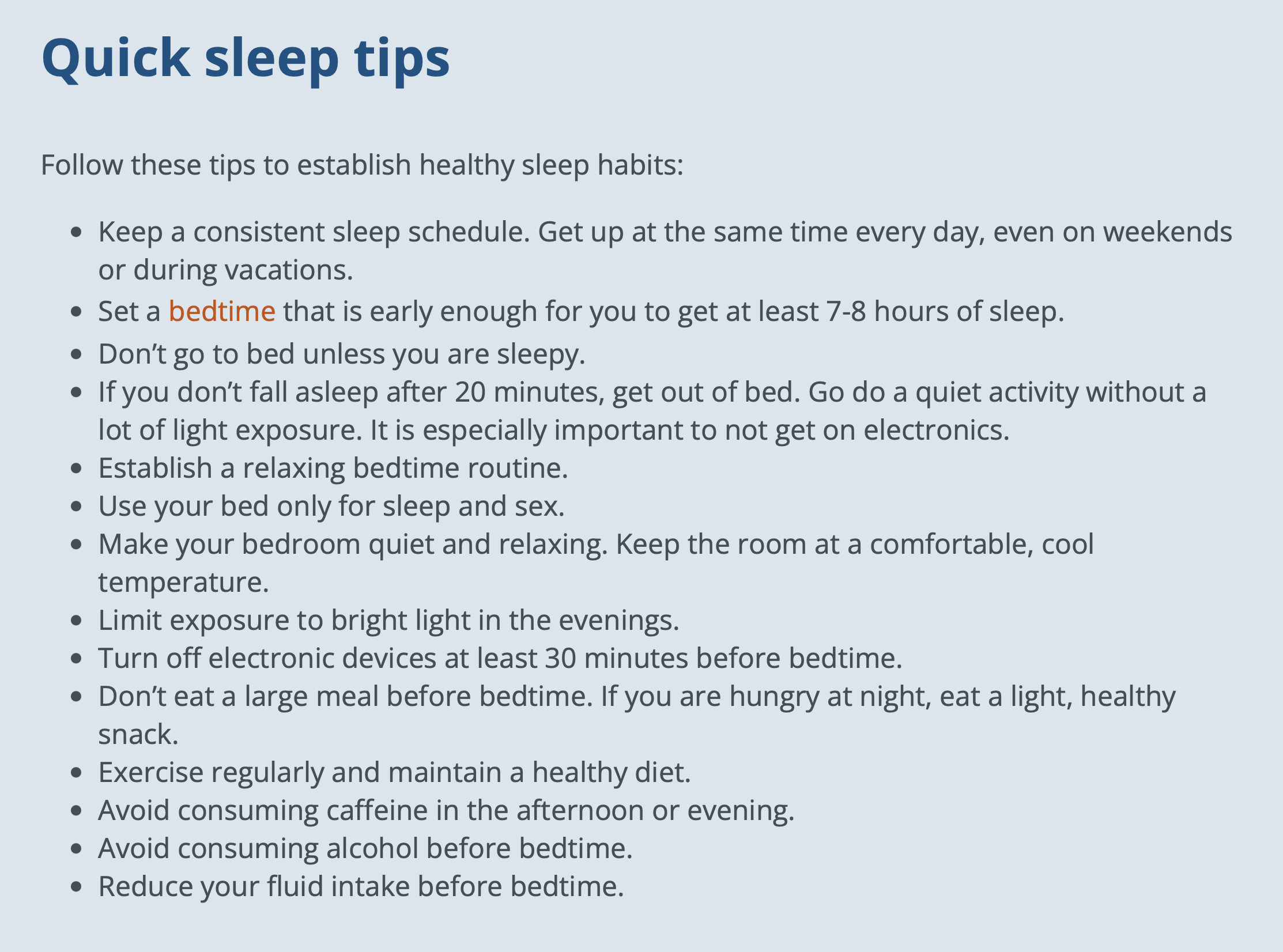 CDC: Tips for Better Sleep
https://www.cdc.gov/sleep/
CDC: Tips for Better Sleep
https://www.cdc.gov/sleep/
 Mayo Clinic: Sleep tips: 6 steps to better sleep
https://www.mayoclinic.org/healthy-lifestyle/adult-health/in-depth/sleep/art-20048379
You're not doomed to toss and turn every night. Consider
simple tips for better sleep, from setting a sleep schedule
to including physical activity in your daily routine.
Many factors can interfere with a good night's sleep - from
work stress and family responsibilities to illnesses. It's
no wonder that quality sleep is sometimes elusive.
You might not be able to control the factors that interfere
with your sleep. However, you can adopt habits that
encourage better sleep. Start with these simple tips.
1. Stick to a sleep schedule
2. Pay attention to what you eat and drink
3. Create a restful environment
4. Limit daytime naps
5. Include physical activity in your daily routine
6. Manage worries
Mayo Clinic: Sleep tips: 6 steps to better sleep
https://www.mayoclinic.org/healthy-lifestyle/adult-health/in-depth/sleep/art-20048379
You're not doomed to toss and turn every night. Consider
simple tips for better sleep, from setting a sleep schedule
to including physical activity in your daily routine.
Many factors can interfere with a good night's sleep - from
work stress and family responsibilities to illnesses. It's
no wonder that quality sleep is sometimes elusive.
You might not be able to control the factors that interfere
with your sleep. However, you can adopt habits that
encourage better sleep. Start with these simple tips.
1. Stick to a sleep schedule
2. Pay attention to what you eat and drink
3. Create a restful environment
4. Limit daytime naps
5. Include physical activity in your daily routine
6. Manage worries

Insomnia (inability to sleep)
Progressive Muscle Relaxation Script
https://www.therapistaid.com/worksheets/progressive-muscle-relaxation-script
Progressive muscle relaxation is an exercise that reduces
stress and anxiety in your body by having you slowly tense
and then relax each muscle. This exercise can provide an
immediate feeling of relaxation, but it's best to practice
frequently. With experience, you will become more aware of
when you are experiencing tension and you will have the
skills to help you relax.
During this exercise, each muscle should be tensed, but not
to the point of strain. If you have any injuries or pain,
you can skip the affected areas. Pay special attention to
the feeling of releasing tension in each muscle and the
resulting feeling of relaxation.
Free Relaxation Scripts
https://www.innerhealthstudio.com/relaxation-scripts.html
The free relaxation scripts provided here allow you to learn
to quickly and easily relax at home. You can use these
written materials to record your own relaxation audio or
learn to relax.
The scripts here are for personal use, or they may be used
to facilitate relaxation sessions at no charge to clients.
What Is the 4-7-8 Breathing Technique?
https://www.healthline.com/health/4-7-8-breathing
The 4-7-8 breathing may help you better manage your
breathing. It involves inhaling for 4 seconds, holding your
breath for 7 seconds, and exhaling for 8 seconds.
This is typically practiced as a cycle, where you repeat the
breathing sequence for a desired amount of time.
Based on an ancient yogic method called pranayama, the 4-7-8
technique may support your overall well-being with
consistent practice. When practiced regularly, it could also
help some people fall asleep in a shorter period of time.
How does the 4-7-8 breathing technique work?
The 4-7-8 breathing technique can be effective in various
ways. Many people may use it to help them rest. It can also
help you cope with mental health conditions that may present
challenges in your day-to-day life.
This practice can provide a sense of relaxation, as well as
improve how your body responds to stress. In these ways, you
may consider this technique as a method of encouraging
positive change in your mental and physical health.
You may incorporate 4-7-8 breathing in your daily routine to
help provide the following benefits.
Improve heart health
Breathing techniques are designed to bring your body into a
state of deep relaxation.
Specific patterns that involve holding your breath for a
period of time allow your body to replenish its oxygen.
Techniques like 4-7-8 can give your organs and tissues a
much-needed oxygen boost from your lungs outward.
Brief structured respiration practices enhance mood and reduce
physiological arousal
https://doi.org/10.1016/j.xcrm.2022.100895
 Mayo Clinic: How to manage daylight saving time
https://www.mayoclinichealthsystem.org/hometown-health/speaking-of-health/how-to-manage-daylight-saving-time
Mayo Clinic: How to manage daylight saving time
https://www.mayoclinichealthsystem.org/hometown-health/speaking-of-health/how-to-manage-daylight-saving-time
Sleep Apnea (stopped breathing)
Resvent iBreeze Auto CPAP Machine Review 2022
https://cpapsupplies.com/blog/resvent-ibreeze-auto-cpap-machine-review
Continuous positive airway pressure (CPAP) therapy is a
common treatment for obstructive sleep apnea.
The Resvent iBreeze Auto CPAP machine has emerged as an
innovative, feature-packed option for sleep apnea treatment
in recent months. This is great news for those who have had
a hard time finding a CPAP machine after Philips Respironics
machines being recalled, which included many DreamStation
models. The resulting surge in demand for ResMed AirSense 10
machines created a shortage of those products, and now users
are left with fewer options.
Fortunately, the iBreeze APAP machine has been granted
emergency use authorization by the FDA. iBreeze series
machines are now widely accessible for people who are newly
diagnosed with sleep apnea, or who simply need to replace a
worn out machine.
While commonly referred to as an auto CPAP machine, the
Resvent iBreeze is actually an APAP machine, which provides
automatic positive airway pressure as opposed to continuous
positive airway pressure. The difference is that an APAP
machine automatically adjusts the pressure level on a
breath-by-breath basis to meet your needs rather than
providing the same fixed level throughout the night. This
makes it easier for people who struggle to adjust to
standard CPAP therapy.
Mary Greeley Medical Center Home Medical Equipment issued
a Resvent iBreeze Auto CPAP machine to me, as I was
diagnosed with moderate to severe sleep apnea last fall.
 The CPAP info screen shows that on the night beginning on
3/31/2023 the CPAP was in use for 8.1 hours and recorded an
average apnea-hypopnea index rate of no more than 0.1 events
per hour.
The fresh filtered (and humidity controlled) air for
comfortable quiet sleeping, is a joy. I embraced this new
way of sleeping on the very first night--actually in the
first five minutes. Smiling!
Alternative?
Blowing a Conch Shell Each Day Could Help Treat Sleep Apnea
https://www.sciencealert.com/blowing-a-conch-shell-each-day-could-help-treat-sleep-apnea
Ultimately, researchers found that participants in the
conch-blowing group slept better and woke up the next day
feeling substantially more rested than the deep breathing
group.
"The standard treatment for OSA is a continuous positive
airway pressure machine, or CPAP, which keeps the patient's
airway open by blowing air through a facemask throughout the
night," explains pulmonologist Krishna K. Sharma from the
Eternal Heart Care Centre and Research Institute in Jaipur,
India.
"While effective, many patients find it uncomfortable and
struggle to use it consistently."
Regular breathing exercises like conch blowing could be a
useful alternative.
The CPAP info screen shows that on the night beginning on
3/31/2023 the CPAP was in use for 8.1 hours and recorded an
average apnea-hypopnea index rate of no more than 0.1 events
per hour.
The fresh filtered (and humidity controlled) air for
comfortable quiet sleeping, is a joy. I embraced this new
way of sleeping on the very first night--actually in the
first five minutes. Smiling!
Alternative?
Blowing a Conch Shell Each Day Could Help Treat Sleep Apnea
https://www.sciencealert.com/blowing-a-conch-shell-each-day-could-help-treat-sleep-apnea
Ultimately, researchers found that participants in the
conch-blowing group slept better and woke up the next day
feeling substantially more rested than the deep breathing
group.
"The standard treatment for OSA is a continuous positive
airway pressure machine, or CPAP, which keeps the patient's
airway open by blowing air through a facemask throughout the
night," explains pulmonologist Krishna K. Sharma from the
Eternal Heart Care Centre and Research Institute in Jaipur,
India.
"While effective, many patients find it uncomfortable and
struggle to use it consistently."
Regular breathing exercises like conch blowing could be a
useful alternative.
Restless legs syndrome (RLS)
Mayo Clinic: Restless legs syndrome
https://www.mayoclinic.org/diseases-conditions/restless-legs-syndrome/symptoms-causes/syc-20377168
Restless legs syndrome (RLS) is a condition that causes an
uncontrollable urge to move the legs, usually because of an
uncomfortable sensation. It typically happens in the evening
or nighttime hours when you're sitting or lying down. Moving
eases the unpleasant feeling temporarily.
Restless legs syndrome, also known as Willis-Ekbom disease,
can begin at any age and generally worsens as you age. It
can disrupt sleep, which interferes with daily activities.
Simple self-care steps and lifestyle changes may help
relieve symptoms. Medications also help many people with
RLS.
NIH: Restless legs syndrome
https://www.ninds.nih.gov/health-information/disorders/restless-legs-syndrome

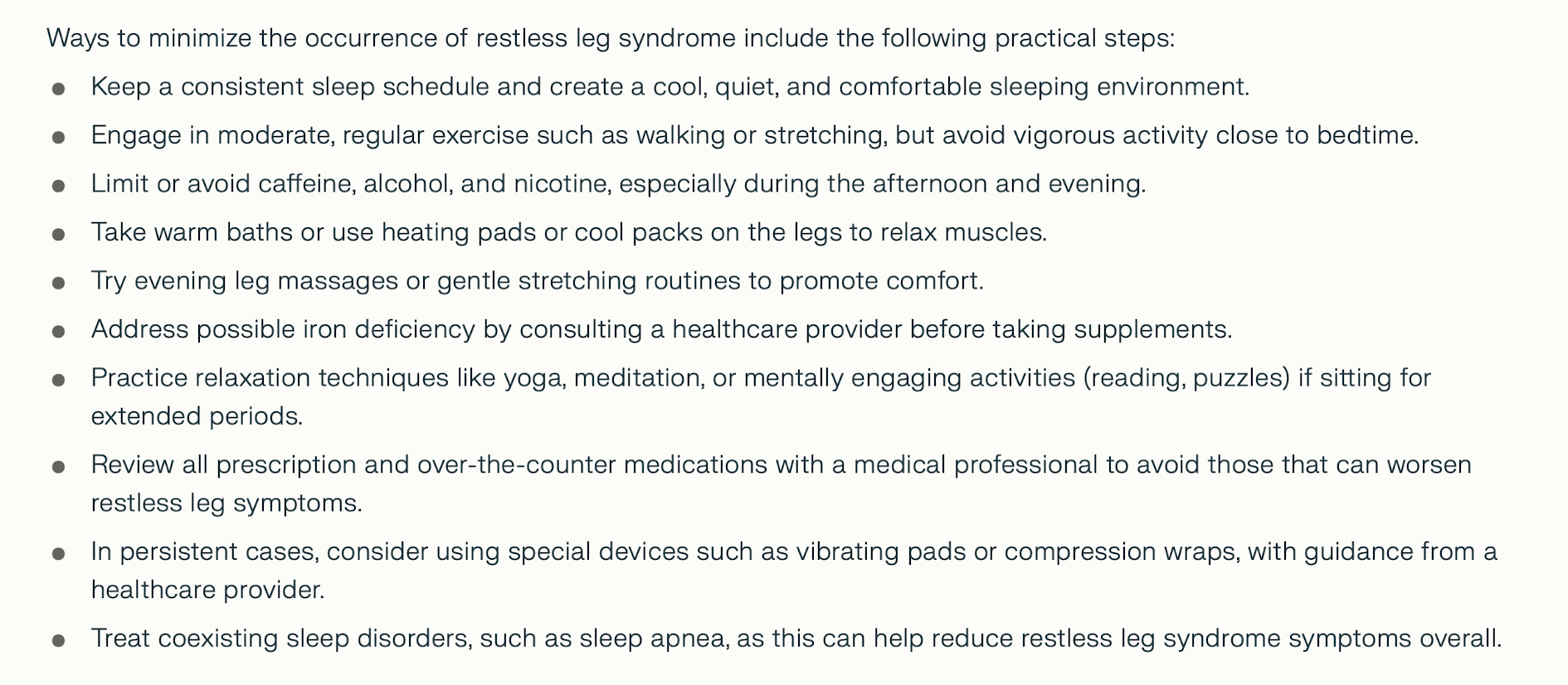 sam.wormley@icloud.com
sam.wormley@icloud.com
The Rime of the Ancient Mariner (text of 1834) By Samuel Taylor Coleridge https://www.poetryfoundation.org/poems/43997/the-rime-of-the-ancient-mariner-text-of-1834 PART V Oh sleep! it is a gentle thing, Beloved from pole to pole! To Mary Queen the praise be given! She sent the gentle sleep from Heaven, That slid into my soul. The silly buckets on the deck, That had so long remained, I dreamt that they were filled with dew; And when I awoke, it rained.


Understanding Sleep Stages While you're sleeping, your body goes in and out of different stages of sleep. In general, a sleep stage is determined by the types of brain waves you produce. Most people will cycle through the different stages several times during a sleep session. While scientists and doctors can recognize which stage you're in, they're still working to fully understand the impact each stage has on the body. Awake You may find yourself awake during parts of a sleep session. It's normal for people to wake up on occasion. It's possible that you will fall right back to sleep and not remember waking up during the night. REM Sleep (N4) This stage of sleep may play a role in learning and memory. During this stage, your muscles are the most relaxed and your eyes move rapidly from side to side. This is also when most of your dreams occur. Core Sleep (N1,N2) Sometimes referred to as light sleep, this stage is considered just as important as the others. This stage often represents most of your time asleep each night. Brain waves that may be important for cognition occur during this stage. Deep Sleep (N3) Also known as slow wave sleep because of the brain wave patterns, this is the stage where body tissues are repaired and essential hormones are released. This stage typically happens in longer periods during the first half of your sleep session. During deep sleep, the body is so relaxed that it can be more difficult to wake up from this stage than others. Understanding Your Sleep Stages There are many misconceptions around sleep stages and the quality of sleep. While some may need more deep sleep, others may not. Scientists and doctors are continuing to explore the purpose of the different stages and the impact they have on the body. By tracking your sleep stages and paying attention to how you feel each morning, you may gain insight into your own sleep.
CDC: Tips for Better Sleep https://www.cdc.gov/sleep/
Mayo Clinic: Sleep tips: 6 steps to better sleep https://www.mayoclinic.org/healthy-lifestyle/adult-health/in-depth/sleep/art-20048379 You're not doomed to toss and turn every night. Consider simple tips for better sleep, from setting a sleep schedule to including physical activity in your daily routine. Many factors can interfere with a good night's sleep - from work stress and family responsibilities to illnesses. It's no wonder that quality sleep is sometimes elusive. You might not be able to control the factors that interfere with your sleep. However, you can adopt habits that encourage better sleep. Start with these simple tips. 1. Stick to a sleep schedule 2. Pay attention to what you eat and drink 3. Create a restful environment 4. Limit daytime naps 5. Include physical activity in your daily routine 6. Manage worries

Mayo Clinic: How to manage daylight saving time https://www.mayoclinichealthsystem.org/hometown-health/speaking-of-health/how-to-manage-daylight-saving-time
The CPAP info screen shows that on the night beginning on 3/31/2023 the CPAP was in use for 8.1 hours and recorded an average apnea-hypopnea index rate of no more than 0.1 events per hour. The fresh filtered (and humidity controlled) air for comfortable quiet sleeping, is a joy. I embraced this new way of sleeping on the very first night--actually in the first five minutes. Smiling! Alternative? Blowing a Conch Shell Each Day Could Help Treat Sleep Apnea https://www.sciencealert.com/blowing-a-conch-shell-each-day-could-help-treat-sleep-apnea Ultimately, researchers found that participants in the conch-blowing group slept better and woke up the next day feeling substantially more rested than the deep breathing group. "The standard treatment for OSA is a continuous positive airway pressure machine, or CPAP, which keeps the patient's airway open by blowing air through a facemask throughout the night," explains pulmonologist Krishna K. Sharma from the Eternal Heart Care Centre and Research Institute in Jaipur, India. "While effective, many patients find it uncomfortable and struggle to use it consistently." Regular breathing exercises like conch blowing could be a useful alternative.

sam.wormley@icloud.com